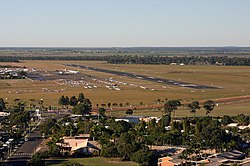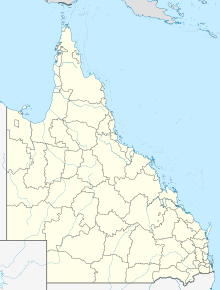Bundaberg Airport (IATA: BDB[4], ICAO: YBUD) is a regional airport serving Bundaberg, a city in the Australian state of Queensland.[2] It is located 2.5 nautical miles (4.6 km; 2.9 mi) southwest[2] of the city centre, on North Childers Road and Takalvan Street.[5] The airport is owned and operated by the Bundaberg Regional Council.[2][6] It is also known as Bundaberg Regional Airport.[6]
Bundaberg Airport Bundaberg Regional Airport | |||||||||||||||
|---|---|---|---|---|---|---|---|---|---|---|---|---|---|---|---|
 | |||||||||||||||
| Summary | |||||||||||||||
| Airport type | Public | ||||||||||||||
| Owner/Operator | Bundaberg Regional Council | ||||||||||||||
| Serves | Bundaberg, Queensland, Australia | ||||||||||||||
| Opened | 12 December 1931 | ||||||||||||||
| Elevation AMSL | 107 ft / 33 m | ||||||||||||||
| Coordinates | 24°54′14″S 152°19′07″E / 24.90389°S 152.31861°E | ||||||||||||||
| Website | bundaberg | ||||||||||||||
| Map | |||||||||||||||
| Runways | |||||||||||||||
| |||||||||||||||
| Statistics (2010–2011[1]) | |||||||||||||||
| |||||||||||||||
The Royal Flying Doctor Service has one of its nine Queensland bases at Bundaberg Airport.[7]
The Bundaberg Regional Council conducted major works on the runway, terminal, carpark and navigation aids in 2009–10 in an attempt to attract services using A320/737 type aircraft.
History
editThe airport was officially opened on 12 December 1931, by the Minister for Trade and Customs, the Hon. Frank Forde, M.H.R., as a civilian airport. The airport was renamed in 1936 to Hinkler Airport after Bundaberg's famous aviator Bert Hinkler[8][9][10]
In February 2022, Bonza announced that the airport would become one of its 17 destinations with the airline planning to fly to Melbourne from Bundaberg [11]
World War II
editWith the outbreak of World War II, it was decided as part of the Empire Air Training Scheme to requisition Bundaberg Airport and develop it as a Royal Australian Air Force (RAAF) Flying Training School.
Known as RAAF Station Bundaberg it was initially used in 1941 by No. 12 Elementary Flying Training School RAAF (12 EFTS), until 12 EFTS relocated to Lowood Aerodrome (located at Tarampa) on 12 January 1942. No. 8 Service Flying Training School RAAF then operated from the base.
Units Based at Bundaberg
edit- No. 32 Squadron RAAF ('B' Flight) – 1 May 1943 – 4 September 1944
- No. 66 Squadron RAAF – 20 May 1943 – 6 January 1944
- No. 71 Squadron RAAF ('B' Flight) – 1 May 1942 – 26 January 1943
- No. 8 Service Flying Training School RAAF – 14 December 1941 – 25 July 1945
- No. 12 Elementary Flying Training School RAAF – 16 October 1941 – 12 January 1942
- No. 88 Operational Base Unit RAAF – 14 June 1945 – 26 April 1946
- Royal Netherlands East Indies Army Air Force Personnel & equipment pool – 25 June 1945 – 26 April 1946.
Bundaberg War Graves
editLocated within the Bundaberg General Cemetery, it contains the burial places of 46 soldiers and airmen of the Australian Forces and five airmen of the United States Army Air Corps.[12]
Post war
editThe Department of Civil Aviation took over Bundaberg Aerodrome on 31 July 1946. Bundaberg City Council took over the airport in June 1983. A new terminal was opened on 9 May 1986. A major extension to Bundaberg Airport was completed in March 2010, making the runway jet capable and also including an expanded Terminal.
Facilities
editThe airport resides at an elevation of 107 ft (33 m) above sea level. It has two runways: 14/32 with an asphalt surface measuring 2,000 m × 30 m (6,562 ft × 98 ft) and 07/25 with a grassed grey silt clay surface measuring 1,128 m × 30 m (3,701 ft × 98 ft).[2]
Airlines and destinations
edit| Airlines | Destinations |
|---|---|
| Link Airways | Brisbane[13] |
| QantasLink | Brisbane |
| Seair Pacific | Lady Elliot Island |
Statistics
editBundaberg Airport was ranked 41st in Australia for the number of revenue passengers served in financial year 2010–2011.[1][3]
| Year[1] | Revenue passengers | Aircraft movements |
|---|---|---|
| 2001–02 | 54,351 | 3,546 |
| 2002–03 | 56,549 | 2,723 |
| 2003–04 | 66,716 | 2,522 |
| 2004–05 | 87,377 | 2,915 |
| 2005–06 | 98,276 | 3,161 |
| 2006–07 | 103,946 | 3,103 |
| 2007–08 | 116,572 | 3,010 |
| 2008–09 | 114,715 | 2,673 |
| 2009–10 | 115,889 | 2,508 |
| 2010–11 | 132,731 | 2,832 |
See also
editReferences
editExternal links
edit



